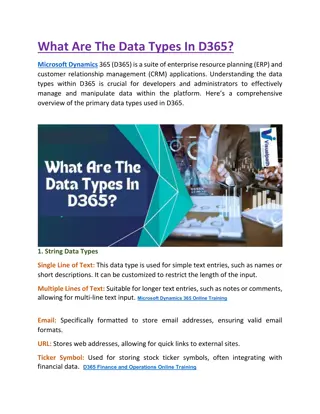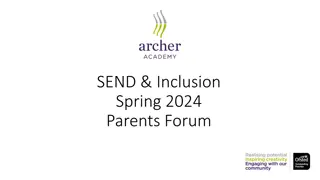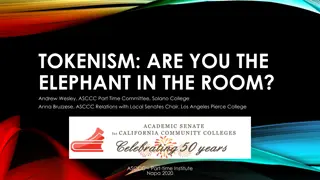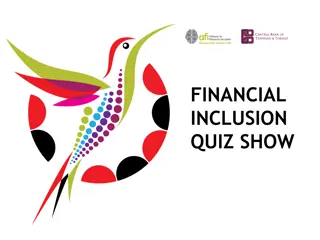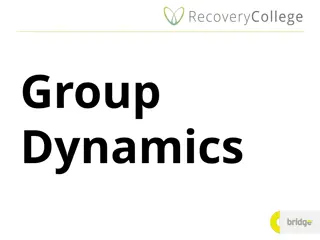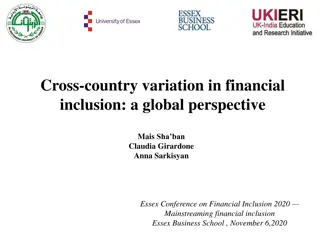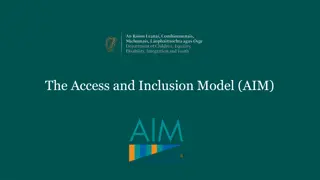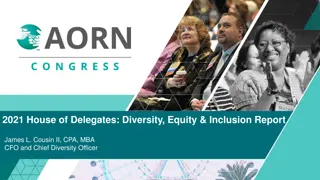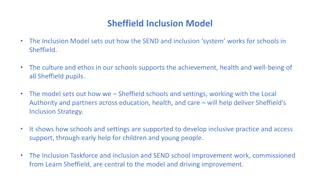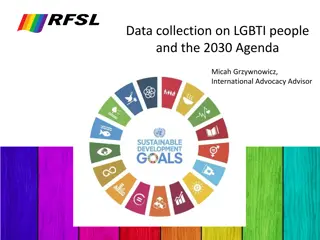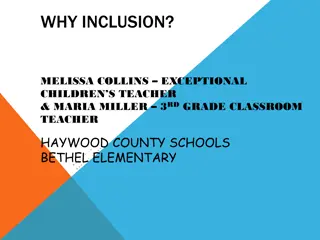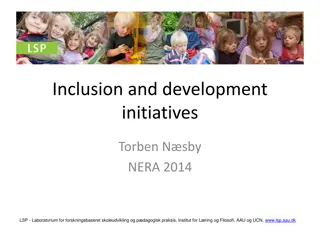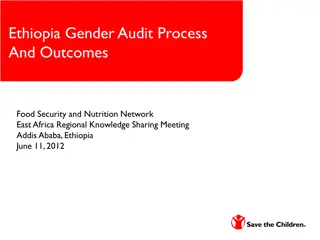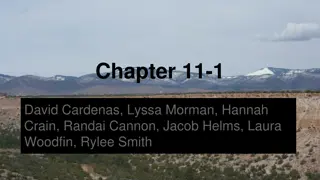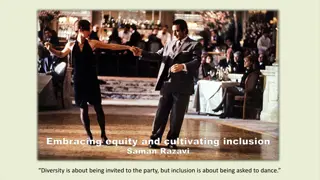Understanding the Role of Inclusion in Group Dynamics
Explore the importance of inclusion in group dynamics, how diverse perspectives enhance group performance, and strategies to empower all members in achieving common goals. Case studies and discussions are used to illustrate effective facilitation of group dynamics for better engagement and collaboration.
Download Presentation

Please find below an Image/Link to download the presentation.
The content on the website is provided AS IS for your information and personal use only. It may not be sold, licensed, or shared on other websites without obtaining consent from the author. Download presentation by click this link. If you encounter any issues during the download, it is possible that the publisher has removed the file from their server.
E N D
Presentation Transcript
SYNTHESIS Recognizing the Role of Inclusion in Group Dynamics Presented by: Julius W. Mayo III The Office of Student Life at The Ohio State University
Sesquicentennial Student Scholar Leadership Program Agenda Welcome and Introductions About this Session Getting Started Group Theory Theory to Practice Synthesis 2
Sesquicentennial Student Scholar Leadership Program Ice Breaker Name/ Major/ Field of Study/Campus What is one example of the best or worst experience you have ever had with group dynamics within an organization of which you were a part? 3
Sesquicentennial Student Scholar Leadership Program About this Session: As a leader, it is imperative to recognize the unique attributes each member brings to a group. Organizations working toward creating group goals and expectations often encounter differences in viewpoints and perspectives that produce a need for intentional dialogue, reflection, and group action. This session will explore ways for groups to maximize strategies that allow diverse groups to be better able to live and learn with each other. This session will use case studies, discussion, and research to explore ways to facilitate group dynamics in ways that empower and engage all those involved. 4
Sesquicentennial Student Scholar Leadership Program Getting Started 5
Sesquicentennial Student Scholar Leadership Program Group Dynamics are the influential actions, processes and changes that take place within a collection of members. Factors that can affect group dynamics: Membership roles (influencers, followers, first adopters) Feelings of safety or comfort Context Social identities of students Sense of connectedness 6
Sesquicentennial Student Scholar Leadership Program Tuckman Model of Group Development (1965) Tuckman Model of Group Development (1965) 7
Sesquicentennial Student Scholar Leadership Program 8
Sesquicentennial Student Scholar Leadership Program The Forming Stage is characterized by a need for group members to begin to identify and manage personal and group boundaries Key Themes: It s not the same for everyone- factors such as social class, lived experiences, and diverse perspectives result in differences in group needs and expectations Diversity makes things more interesting Before establishing agreed upon norms and values, group members will likely tread likely so as not to cross boundaries in terms of identity issues such as orientation, race, gender, or political viewpoints Differences in how group members choose to explore boundaries can create cohesion or division if not facilitated well 9
Sesquicentennial Student Scholar Leadership Program Strategies: Intentional group Orientations Icebreakers and Energizers Intentional forum for new ideas and perspectives Reflection 10
Sesquicentennial Student Scholar Leadership Program The Storming Stage is characterized by a distinct conflict with or challenge to the views, attitudes, or behaviors of others. Key Themes: It s about to get real-factors that could be overlooked, or ignored for a certain period of time, can no longer be tolerated and must be confronted Why are we here? the group begins to look for clarity or a better understanding of why things are the way they are within an organization. If things to don t seem to jibe with what is expected, concerns arise. Boundaries are crossed in a triggering manner an event or set of events elicits an emotional response from certain members of the group often because of perceived sense of being targeted or marginalized (vocab check) 11
Sesquicentennial Student Scholar Leadership Program Strategies: Keep calm and process on Listen first for understanding Intentional forum for new ideas and perspectives Recognize who is (and who isn t in the room) and how this dynamic affects the group 12
Sesquicentennial Student Scholar Leadership Program The Norming Stage is characterized by working toward consensus, group understanding and mutual respect. Key Themes: I feel connected-individuals understand and appreciate their role and importance within the organization This is how we do it- the group understands the rationale and motivation for group norms and values, and is willing to demonstrate behaviors that support these goals when necessary Appreciating the learning moments is the norm Not only is it important address words or actions that harm or hurt group members but also a sincere willingness to learn from these experiences. 13
Sesquicentennial Student Scholar Leadership Program Strategies: Recognize making mistakes is part of the learning process Be willing to say you re sorry Listen and Learn Take action 14
Sesquicentennial Student Scholar Leadership Program The Performing Stage is characterized by using consensus and mutual group understanding to achieve a collective action or goal. Key Themes: We got this- there is a sense of group confidence in which all members can accomplish an objective because everyone in the group has the competence to do it together Delegation everyone knows their part or role, and feels comfortable enough with it to take on a specific task or action to achieve a group goal Theory is now in practice The group not only talks about their mission and values, but is able to put into action in terms of how they engage with each other and with others outside the group 15
Sesquicentennial Student Scholar Leadership Program Strategies: Recognize challenges and develop collective approaches for finding solutions Be willing to share group responsibilities and actions Identify ways to show each other and others how effectively the group can work together 16 Take action
Sesquicentennial Student Scholar Leadership Program The Adjourning Stage is characterized the group recognizing what they have accomplished, and thinking about what happens next. Key Themes: Thank you, next! -appreciation is an essential way to help individuals want to remain invested in an organization, and to possibly seek out new ways to advance the goals and mission of the group. What did we learn? reflection allows the group to think about what went well, what can be improved, and what should not be included in future efforts. It also helps ensure that everyone understands how group actions are connected to the organizational goal and mission. That s the end? while for some members the adjourning stage is primarily about celebration what was accomplished, and what comes next, it is 17
Sesquicentennial Student Scholar Leadership Program Strategies: Recognition trinkets, cards or keepsakes Potlucks, parties, recognition events Creative reflection activities Closing Traditions 18
Synthesis 19
Sesquicentennial Student Scholar Leadership Program CASE STUDY ONE CASE STUDY ONE pretty excited to coordinate a volunteer project in which the entire organization was able to provide a hot meal, warm clothes, and couple of hours of conversation with residents at a local drop-in center for homeless youth. As a wrap up to the day, the college group came together to reflect on their experiences during the day. The majority of the group discussed how happy they were to be able to do a project that was so directly related to the goals and mission of the organization. Another member mentioned how great it was to help others in need. Not everyone in the group shared the same enthusiasm for the experience as others, however. Nico, who was unable to attend any of Buckeye Action s meetings and events before this volunteer day, including the orientation meetings, was clearly displeased with his first task with the group. Honestly, I think this was a waste of time, he commented. Look at how half the people we were supposedly helping today are dressed! They have clothes nicer than mine, and what s up with the cell phones? If they re so in need, what do they need with a phone? Several members of the group were visibly unhappy with Nico s comments. Who is he, and why is he even here? one member wondered out loud. Zadie knew there were some interesting group dynamics going on, but was unsure what to do, and how things could have gone differently. What do you think should happen? As service chair for Buckeye Action (a campus community outreach organization), Zadie was 20
Sesquicentennial Student Scholar Leadership Program CASE STUDY TWO CASE STUDY TWO gender pronouns were they, them and their, they noticed that Evan had once again rolled his eyes to express his displeasure. This was not the first time this had happened. During early Fall semester, Kai brought up the issue during a group forum designed to allow members to share their thoughts on the organization. Evan made it clear that in his opinion the mission of the group was to learn about and address important issues on campus. Kai argued that gender inclusion was an important issue on campus, and in-line with the mission of the group. After several hours of heated debate, the president of the organization announced that the discussion would be tabled indefinitely in order to maintain order within the group. For some in the group, silence was golden in terms of keeping the peace. For others it was unbearable, especially when they believed in the mission and goals of the organization but were silenced when trying to express new and differing viewpoints. They had chosen to leave the organization for good. Kai had elected to remain with the group in order to someday affect change. What are your thoughts on the group dynamics at play here. How could the organization be changed/saved? Or, should it? As Kai self-identified to the new members of the Brutus Leadership Organization that their 21
Sesquicentennial Student Scholar Leadership Program Closing Thoughts, Questions, Comments Closing Thoughts, Questions, Comments 22
Sesquicentennial Student Scholar Leadership Program 23
Sesquicentennial Student Scholar Leadership Program Selected References Selected References Forming Resistance and Immersion- Cultural Identity Development (Akinson, Morten, and Sue; 1979, 1989, 1993, 1998) Immersion-Emersion- Racial and Cultural Identity Development (Cross and Fhagen-Smith, 2001) Disintegration- Model of White Identity Development ( Helms, 1995) Norming/Storming Dissonance- Cultural Identity Development (Akinson, Morten, and Sue; 1979, 1989, 1993, 1998) Encounter- Racial and Cultural Identity Development (Cross and Fhagen-Smith, 2001) Contact- Model of White Identity Development ( Helms, 1995) General Tuckman, B. W., & Jensen, M. A. C. (1977). Stages of small-group development revisited. Group & Organization Studies, 2(4), 419-427. Welch, M. (1999). The ABCs of reflection: A template for students and instructors to implement written reflection in service-learning. NSEE quarterly, 25(2). 24





